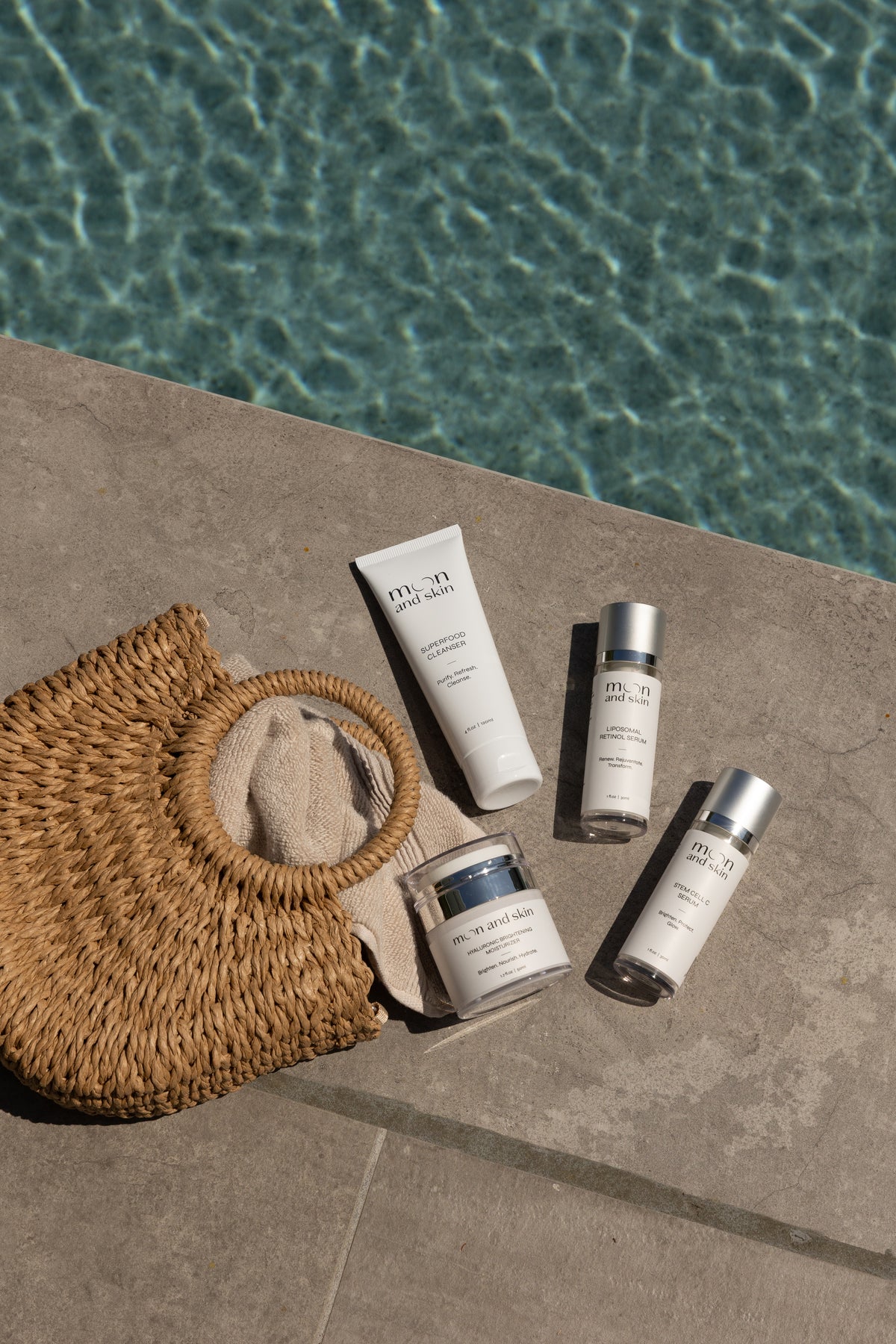Table of Contents
Introduction
Did you know that the skin is our largest organ and plays a crucial role in protecting us from external elements? Yet, many of us often overlook the importance of a consistent skincare routine. Navigating the world of skincare can feel overwhelming—especially with so many products and advice available. We understand that finding the best skin care routine tailored to your unique needs is essential for achieving that radiant, healthy glow.
In this blog post, we will break down the essential steps of an effective skincare routine, explore the benefits of various ingredients, and highlight how our Moon and Skin products can help you along your journey. From cleansing to sun protection, we'll guide you through each stage, ensuring you have the knowledge to make informed choices for your skin. Together, let's discover how to nurture and celebrate your skin through every phase of life.
Understanding Your Skin Type
Before diving into the specifics of a skincare routine, it's vital to understand your skin type. Different skin types require different care, and knowing yours will help you choose the right products. Here are the most common skin types:
- Normal: Balanced moisture levels, few imperfections, and a smooth texture.
- Dry: Lacks oil, feels tight, and may have flakiness or rough patches.
- Oily: Excess sebum production, shiny appearance, and prone to breakouts.
- Combination: A mix of dry and oily areas, often oily in the T-zone (forehead, nose, chin) and dry on the cheeks.
- Sensitive: Prone to redness, irritation, or allergic reactions.
Understanding your skin type will assist you in selecting products that align with your needs. For instance, if you have dry skin, you may benefit from our Hyaluronic Brightening Moisturizer, which deeply hydrates while brightening your complexion.
The Essential Steps of a Skin Care Routine
1. Cleansing
Cleansing is the foundation of any skincare routine. It removes dirt, oil, makeup, and impurities, preparing your skin for the subsequent steps. We recommend using a gentle cleanser that suits your skin type. For all skin types, our Superfood Cleanser is an excellent choice, formulated with HydroProtein Technology to cleanse without stripping moisture.
How to Cleanse:
- Use lukewarm water to wet your face.
- Apply a small amount of cleanser and gently massage in circular motions.
- Rinse thoroughly and pat dry with a clean towel.
2. Toning
Toning is often overlooked, but it's a vital step that helps balance your skin's pH levels and adds hydration. Modern toners are hydrating and often contain beneficial ingredients like antioxidants. While toners may not be essential for everyone, they can enhance your skincare routine.
If you choose to include a toner, look for one that is alcohol-free and hydrating. This will help your skin feel refreshed and prepare it for the next steps.
3. Exfoliating
Exfoliation helps remove dead skin cells and promotes cell turnover. Regular exfoliation can improve skin texture and radiance. Depending on your skin type, you may choose between physical (scrubs) and chemical (acids) exfoliants. Generally, we recommend exfoliating 1-2 times a week.
For those with sensitive skin, opt for gentle exfoliants that won't irritate your skin.
4. Masking
Face masks are a great way to provide your skin with concentrated nutrients. Whether you're looking to hydrate, brighten, or detoxify your skin, masks can be tailored to your skin's needs. Use a mask once or twice a week for best results.
5. Treatment: Serums and Concentrates
This is where you can target specific skin concerns, such as fine lines, dark spots, or acne. Serums are lightweight and packed with active ingredients. Our Stem Cell C Serum is a fantastic choice to brighten and hydrate your skin, thanks to its advanced plant-cell technology and stable vitamin C.
How to Apply a Serum:
- After cleansing and toning, apply a few drops of serum to your fingertips.
- Gently press the serum onto your skin, focusing on areas of concern.
6. Moisturizing
Moisturizing is crucial for all skin types, even oily skin. It helps lock in hydration and keeps your skin barrier healthy. Our Hyaluronic Brightening Moisturizer is perfect for those seeking hydration without heaviness.
How to Moisturize:
- Apply a pea-sized amount of moisturizer to your face and neck.
- Use upward strokes to ensure even distribution.
7. Eye Care
The skin around our eyes is delicate and requires special attention. An eye cream can help address concerns like puffiness, dark circles, and fine lines. Apply a small amount using your ring finger, which has the lightest touch.
8. Sun Protection
The final and most crucial step in your morning routine is applying sunscreen. Protecting your skin from UV damage is essential to prevent premature aging and skin cancer. Look for a broad-spectrum sunscreen with an SPF of at least 30. Consistent use is key to maintaining healthy skin.
Customizing Your Routine
Once you have mastered the fundamental steps of a skincare routine, you can tailor it to address your specific skin type and concerns. Don't hesitate to consult with a dermatologist or esthetician for personalized recommendations. Remember, consistency is key; give your products time to work, and don't be disheartened if results take time.
The Importance of Ingredients
Understanding the ingredients in your skincare products can empower you to make informed choices. Here are some powerful ingredients to look for:
- Vitamin C: Brightens and protects against free radicals.
- Hyaluronic Acid: Hydrates and plumps the skin.
- Retinol: Promotes cell turnover and targets fine lines.
- Niacinamide: Reduces redness and improves skin texture.
By choosing products with these beneficial ingredients, like our Liposomal Retinol Serum, you can effectively address your skin concerns.
Building a Complete Routine with Moon and Skin
At Moon and Skin, we believe in the power of clean, thoughtful skincare that evolves with you. Our products are designed to support your skin at every stage of life. Consider building a complete routine with our Bundle & Save collection, which combines our best-selling products to provide maximum benefits at a great value.
Our Core Products:
Conclusion
Creating the best skincare routine doesn't have to be complicated. By understanding your skin type, following the essential steps, and using high-quality products, you can achieve healthy, glowing skin. We invite you to explore our Bundle & Save collection for a complete routine that supports your journey through every phase of life.
FAQ
What is the best order to apply skincare products? The general rule is to apply products from thinnest to thickest. Start with your cleanser, followed by toner (if using), serums, moisturizer, and finish with sunscreen in the morning.
How often should I exfoliate? Exfoliation should be done 1-2 times a week, depending on your skin type. If you have sensitive skin, opt for gentler exfoliants.
Can I use retinol and vitamin C together? It's generally recommended to use vitamin C in the morning and retinol at night, as retinol can increase sensitivity to sunlight.
What if I have multiple skin concerns? You can customize your routine by using specific products targeted at each concern. For example, use a hydrating serum for dryness and a treatment serum for acne.
How long will it take to see results from a skincare routine? Results can vary, but it's common to see improvements in texture and hydration within a few weeks, while other concerns like pigmentation may take a few months to show results. Consistency is key!







